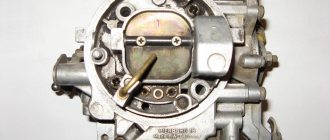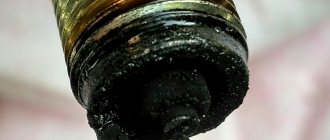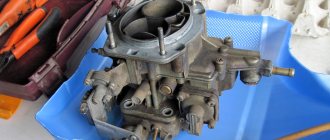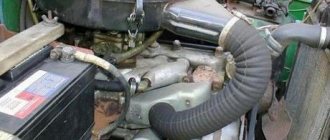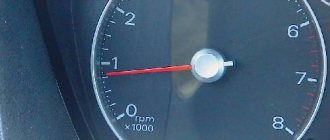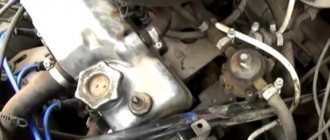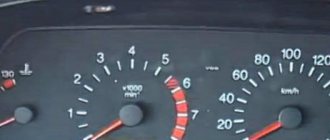The failure of the power unit to operate when cold or after warming up to a certain temperature may indicate a fairly wide list of possible problems. The engine begins to stall both suddenly and to work unstably in different modes, after which the internal combustion engine stops.
We also recommend reading the article about why the engine does not develop full power. From this article you will learn about the causes and ways to solve this problem.
In this article we will talk about the reasons why the engine stops at idle, as a result of which a warm engine stalls, why a car with a hot engine stalls while driving, etc.
A hot engine stalls while driving or idling
Let's start with the fact that the symptoms and signs of this problem can manifest themselves in different ways. Quite often, the power unit may stall in idle mode, and unstable operation and complete stop of the internal combustion engine often occurs after the engine has warmed up.
First of all, diagnostics should begin with checking the spark plugs and their condition. At the same time, high-voltage armored wires should also be checked. This must be done because there may be weak sparking or no spark at all on the spark plug electrodes. Interruptions in the spark lead to serious malfunctions in the operation of the engine, as a result of which both the cold unit and the engine stalls after warming up. Replacing spark plugs and high-voltage wires often helps solve the problem.
Another common situation is when the engine stalls hot or cold immediately after starting it. In this case, on many modern cars with an injection power system, you should check the idle speed sensor. The failure of this element of the electronic engine control system often leads to the fact that the engine is simply unable to operate at idle speed.
In some cases, cleaning the XX regulator helps, in others the device should be replaced. On cars with a carburetor, the idle jets may become clogged and other carburetor malfunctions may occur. Injection engines also require additional checking of the synchronization sensor (DSPS), and possible problems with the fuel pump should not be ruled out. One way or another, if the engine stalls when hot or this constantly happens with a cold unit, then in-depth diagnostics will be required.
If we talk about why a car stalls at idle when the engine warms up, then the reasons may be similar to those cases when a warmed-up unit stops while moving. This happens as a result of heating of certain engine elements, after which thermal expansion occurs and a failure occurs.
On carburetor cars with a mechanical ignition distributor, a situation arises when the slider stops performing its functions. Quite often, after the engine has warmed up, the central wire on the ignition coil may come off, problems with the ignition unit capacitor, etc. may occur. A known problem with cars with a mechanical fuel pump is that the engine stalls in hot weather. This occurs due to overheating, since the high temperature outside and significant heating of the engine compartment do not allow the pump to cool properly.
At the same time, attention should be paid to the condition of the fuel filters. If the filter element becomes clogged, then as the load increases and the speed increases, the required amount of fuel does not flow into the engine through the dirty filter and the engine stalls. We add that usually before a significant decrease in the filter capacity and a complete stop of the motor, the malfunction progresses. At first, the car may not pick up speed, starts poorly, dips appear when you press the gas pedal, the engine is unstable or jerks when you press the accelerator, in transition modes, etc.
Modern cars with an injector have an electronic control unit (ECU). This unit is quite rare, but still fails. In this case, the engine may stall while driving, and the problem itself manifests itself in various situations, including after the internal combustion engine has warmed up. In this case, as well as if it is necessary to check individual ECM sensors, it is necessary to carry out computer diagnostics of the vehicle. The system will display existing errors in the form of codes, after decoding which it is possible to localize the fault. If the problem is “floating”, that is, it occurs periodically, then it is recommended to purchase a compact device that allows you to read information about engine operation via the OBD connector. Thanks to the subsequent display of data on the screen of a smartphone, tablet or laptop with a pre-installed program, this solution will allow you to record failures in real time.
Carburetor repair by specialists is the best solution
If you have a carbureted car, it would be best to find a professional who can service the equipment regularly. Your car will require high-quality maintenance on a regular basis, since the carburetor is constantly becoming clogged and presents more and more problems in operation. Therefore, it would be best to use the services of a specialist who knows his business very well and performs cleaning, regular maintenance and repair of carburetors, as well as all related equipment. The main criteria for choosing a specialist are as follows:
- experience in working with your car model, sufficient professionalism, confirmed by years of work;
- positive reviews from other owners of carburetor cars who received quality service;
- affordable prices - you don’t have to choose an expensive service station, you can cooperate with a private master;
- fairly quick completion of all necessary repair work, but the presence of a guarantee of the quality of the result;
- the possibility of ordering complex work with the purchase of spare parts performed by a specialist in order to relieve oneself of responsibility for the quality of parts;
- other convenient services, as well as the possibility of full vehicle maintenance.
It is convenient when all repairs and maintenance are carried out by one person. This makes it quite easy to get a high-quality working car, since one person or one company is responsible for it. If one person repairs your carburetor, another person maintains the car, and a third person solves problems with the generator, all this is not very convenient for repair work on the car. So it’s better to find a universal specialist and constantly service the car exclusively from him. If you have a Solex carburetor installed on your car, we suggest watching a video about its disassembly and maintenance:
The car stalls when hot
Hello! I have a problem, the car stalls while driving. But everything is in order, after starting it in the morning, while the temperature has not yet reached operating temperature, the car behaves well. It accelerates both moderately and with a sharp press on the gas, everything is fine. As soon as half an hour or forty minutes pass after the start of the ride, confusion begins. When accelerating from a traffic light, it starts to get dull, as if the spark suddenly disappears, when you start to let go of the gas, it seems to pick up again, but as soon as you give it gas, it stalls. I stop, start it again, it starts normally, I can put on the gas. I start driving slowly, accelerate, nod off again. This problem appeared with the onset of heat, especially in traffic jams. I studied the forum in search of reasons, but I couldn’t find anything even approximately. I’ll list what I checked and changed myself: 1. The MAF corrugation - it’s wrapped tape, there are no leaks. 2. Fuel pressure - I rebuilt the fuel pump, installed a Boschevsky one, built a pressure gauge, took measurements, everything is normal. 3. Today I just bought and installed new ignition coils, explosive wires, spark plugs. What could be the problem? Maybe clean the injectors? Then the engine would behave like this even when cold. It seems that everything depends on the temperature; it’s +28-30 outside now. I don’t see this in the evenings. Where else should I look?
Mazda Premasi 2000, 1.8, manual transmission, left hand drive.
Alternatively, bad gasoline. Didn't you look at the errors?
2006 2.5 automatic transmission Nissan X-Trail Elegance left. steering wheel. was 2000 1.8 automatic transmission Mazda premacy lane. etc.
Either there is a problem with the fuel or with the ignition. Somewhere contact is lost when heated. Check the injector chips, coils, camshaft and crankshaft sensors.
Premacy 2001 4 WD FP DE 1.8 7 seats white right hand drive On Premacy.ru I am SERGEY G.
... from many sensors, the ground wire goes to the internal combustion engine, check the tightness of the connection of these wires and, in general, measure the ground from the battery to the internal combustion engine and the car body both in a cold state and when it starts to swagger.
Sorry, I'm limited in my answers. Ask the right questions! @”I'M A ROBOT.”PREMACY '99 1.8l 135 hp 2wd
I have already tried gasoline, changed gas stations... The fuel is normal 2.6-2.7 in the ramp, the pump produces 6 points... According to the chips, I pulled everything out, re-plugged it, the camshaft sensor measured it was normal, the crankshaft sensor works, otherwise there would be interruptions with fuel supply... I agree about the weight, I haven’t checked it yet, tomorrow I’ll see if there are 16 sq. mm wires, I’ll install it additionally... and could the timing belt have an effect? the previous owner changed it, I covered 20 thousand km...
Mazda Premasi 2000, 1.8, manual transmission, left hand drive.
I even tried driving without an air filter, I thought there wasn’t enough air... it didn’t make any difference
Mazda Premasi 2000, 1.8, manual transmission, left hand drive.
Posted by
Erken… What could be the problem? Maybe clean the injectors? Then the engine would behave like this even when cold. It seems that everything depends on the temperature; it’s +28-30 outside now. I don’t see this in the evenings. Where else should I look?
Usually the problem is in the DPRV. It's difficult to catch, it's better to just change it.
Posted by
ErkenI have already tried gasoline, changed gas stations... The fuel is normal 2.6-2.7 in the ramp, the pump produces 6 points... According to the chips, I pulled everything out, re-plugged it, the camshaft sensor measured it was normal, the crankshaft sensor works, otherwise there would be interruptions with fuel supply... I agree about the weight, I haven’t checked it yet, tomorrow I’ll see if there are 16 sq. mm wires, I’ll install it additionally... and could the timing belt have an effect? the previous owner changed it, I covered 20 thousand km...
And check the ground behind the battery. There it clings to the body of the car.
2006 2.5 automatic transmission Nissan X-Trail Elegance left. steering wheel. was 2000 1.8 automatic transmission Mazda premacy lane. etc.
The mass would disappear regardless of temperature. The loss of signal from the DPRV is precisely due to heating.
Message from
Evgeniy NikThe mass would disappear regardless of temperature. The loss of signal from the DPRV is precisely due to heating.
I've seen this.
2006 2.5 automatic transmission Nissan X-Trail Elegance left. steering wheel. was 2000 1.8 automatic transmission Mazda premacy lane. etc.
And from which Mazda do DPRVs approach us? In the Mazda store they offer me for 4500 thousand rubles..
Mazda Premasi 2000, 1.8, manual transmission, left hand drive.
I went to a disassembly site, bought a sensor for 1200 rubles. Driving around the city is limited to short distances because the engine stalls again as soon as it warms up. Before that, I went to the car market, when I arrived I took off my DPRV for a sample, and found that there were traces of friction on the end of the sensor cylinder, like as if the belt was rubbing against the edge. Apparently it got very hot in this place and the sensor was faulty. The very place of the sensor in the mounting location has a small gap, the sensor can be moved to the sides by half a millimeter. Not finding such a sensor at the car market, I went to the auto repair shop, installed the new one I bought there, the car started up and drove off, but after 5-6 minutes. everything started to stall again as before. Now I think maybe the timing belt has stretched or expanded and is touching the sensor with its edge and heating it up. Later I want to open the cover and inspect the condition of the timing belt. There was also a sound similar to the howling of a bearing, but it appears at certain speeds... The timing belt is the last thing I want to look at, I don’t know where to dig next
Mazda Premasi 2000, 1.8, manual transmission, left hand drive.
Did you look at the errors? When you look at the belt, check the marks. Set pot 1 or 4 to TDC and take a look (unscrew all the spark plugs, it’s easier to turn). If the marks are in different directions, make another full revolution of the crankshaft, they should coincide, and the first cylinder should be at top dead center. You can twist it using the crankshaft bolt. There is a key for 21, a spray bottle will do.
2006 2.5 automatic transmission Nissan X-Trail Elegance left. steering wheel. was 2000 1.8 automatic transmission Mazda premacy lane. etc.
count mistakes first!!!
Sorry, I'm limited in my answers. Ask the right questions! @”I'M A ROBOT.”PREMACY '99 1.8l 135 hp 2wd
So, the idea came to pull the sensor out a little, putting a gasket on it, it itself fits tightly to the valve cover body. To begin with, as an experiment, I wound the usual fum tape and inserted it back into place, the gap turned out to be 1.5-2 mm, but when tightening the mounting bolt, the sensor became slightly crooked. But, the car started up, and this howling noise disappeared, and it flew as before. I drove for half an hour, accelerated, pressed the gas all the way, the car went well. Now I cut out a gasket from cardboard, 2 mm thick. I will look at the condition of the timing belt, why it happened that the belt started rubbing against the sensor... Most likely the timing belt needs to be changed...
Mazda Premasi 2000, 1.8, manual transmission, left hand drive.
Most likely the tension roller is falling apart. When this happens, the belt slides out and rubs the plastic casing. There were a couple of cars with this problem. One of them arrived, her belt had already rubbed through the casing and was visible.
2006 2.5 automatic transmission Nissan X-Trail Elegance left. steering wheel. was 2000 1.8 automatic transmission Mazda premacy lane. etc.
The main thing is that the reason was found). What doesn't happen... .
Today I started doing some repairs. I changed the timing belt, tension roller, idler roller and installed a spring. Upon opening, it turned out that the tension roller was loose, which was why there was noise, and the spring stood all stretched out, as if it had been forced and stretched. As a result, the tension roller did not perform its functions; when driving in the heat, the temperature rose and the roller simply dangled, the synchronization of the camshafts with the crankshaft was disturbed and the engine stalled. I installed a new spring after installing the roller, tightened it, checked it, when the belt is tensioned, the spring returns, in general I did everything according to the instructions here. There is nothing complicated. And the service station asked for 2,500 thousand rubles for this work. Thanks to everyone for their help and advice.
Mazda Premasi 2000, 1.8, manual transmission, left hand drive.
Cars with gasoline engines
A gasoline engine may not start after warming up quite often, especially when operating in low temperatures. The fact is that the fuel remaining in the chamber begins to evaporate quickly due to elevated temperatures. Vapors fill all cavities, including the carburetor, manifold, and air filter. As a result, fuel levels in the float chamber decrease and gas plugs occur. The duration of this process depends on the design of the fuel system and on the external temperature conditions.
That is, the reason why a gasoline engine does not warm up after warming up lies in excessive evaporation of gasoline and the formation of an enriched fuel mixture.
Idle speed controller
A common reason for a power unit to stop is a breakdown of the IAC, which is used to regulate speed.
The sensor looks like a small electric motor with a conical needle. It is located on the throttle assembly.
With the help of IAC, the required amount of oxygen is supplied to the engine when the engine is idling.
To check for functionality, it is necessary to disconnect the wire from the sensor while the engine is running. If the car stalls, the sensor is working. If the motor continues to work, the part requires replacement.
How to check the wiring?
There is one, rather risky way to find the cylinder: disconnect the high-voltage cables from the running engine one by one. By disconnecting the power from the ignition, it will be possible to understand which of the cylinders is not working, thereby significantly narrowing the search.
However, there is a risk of electric shock. It is not fatal, but it is quite painful, so you need to take care of your protection. You can start working if you first put on rubber gloves and stand on a rubber mat. Then follow these tips:
- Turn on the engine, raise and secure the hood.
- One by one, you need to disconnect the cables from the spark plugs. You must hold on to the insulation, not the tip of the wiring; you must not touch the body while removing the live wiring.
- If you turn off the slave cylinder, you will hear that the sound of the engine running has changed. But if it is faulty, then nothing will happen.
Cars with carburetor engines (VAZ 2101,2102,2103,2104,2105,2106,2107)
The reasons for this malfunction can be very diverse, but the 2 main ones are a malfunction of the fuel system and the ignition system. The search must be carried out step by step, then the desired result will be obtained. The reason for unstable engine operation is the over-enrichment or depletion of the fuel mixture entering the engine cylinders when the gas pedal is pressed. This should be taken into account when diagnosing faults.
Indirect signs by which you can determine the causes of unstable engine operation when you press the gas pedal.
1. When starting from a stop or idling, a “failure” is felt when you smoothly press the gas pedal. During acceleration and further movement, the engine runs stably.
2. While driving at low and medium speeds, when you press the gas pedal, the car jerks with a possible engine stop. This defect disappears when you press the gas pedal harder.
3. The engine stalls or there is a “failure” when you sharply press the gas pedal at idle, when starting from a stop, accelerating and moving the car at different speeds.
- The accelerator pump is faulty. Eliminated by disassembly, inspection and replacement of damaged parts from repair. set.
- Insufficient gasoline level in the carburetor float chamber. Eliminated by adjusting the position of the float.
If the fuel level in the carburetor float chamber is excessive, the mixture is greatly over-rich and entering the engine cylinders can “flood” the spark plugs. If the level is insufficient, the fuel mixture, on the contrary, is lean and when pressing the gas pedal, the engine does not receive the required amount of fuel and the car slows down instead of accelerating.
Expert answer
ATTENTION! A completely simple way to reduce fuel consumption has been found! Don't believe me? An auto mechanic with 15 years of experience also didn’t believe it until he tried it. And now he saves 35,000 rubles a year on gasoline! Read more"
There can be many reasons; only the main ones are listed in order of importance, with possible methods of checking and eliminating:
Crankshaft sensor malfunction
The crankshaft sensor is the main sensor responsible for the ignition. Before the final failure, it is operational when cold. After starting the engine, it heats up and its geometric dimensions change. This leads to the opening of the thin conductor that is wound around the core of the electromagnetic crankshaft sensor, and the engine begins to stall. It is better to “throw in” a known-good sensor for testing. The sensor is located in the flywheel area.
Cars with diesel engines: causes of malfunction and solutions
Considering the question of why a diesel engine does not start well after warming up, it can be noted that this problem when heating occurs among many owners of cars of all classes. Unlike a gasoline engine, the problems of a diesel engine are not so obvious and trivial.
This problem is common among domestic and imported cars. The reasons for this phenomenon, when the machine refuses to work, are varied:
- Problems with the fluid temperature control sensor. The sensor that records and displays information about the coolant temperature has failed, resulting in the fuel mixture being supplied incorrectly.
- If the electronic device does not function correctly or breaks down, it receives an incorrect impulse, the fuel supply adjustment is disrupted, and after warming up the engine does not start.
- Depressurization of injectors when heated, through which diesel fuel leaks over time. It is found in excess in the combustion chamber, which interferes with the normal operation of the engine. You need to take out the injector and see how wet it is.
- Incorrect operation of the fuel injection pump when heated; in diesel engines this element is often subject to malfunctions. The problem is solved by cooling the rear area of the pump and trying to start again, and the way out of the situation is to replace the plunger pair and bushings.
- Malfunctions of the injector sensors responsible for fuel injection. As a result, the injection angle changes; to solve the problem, it is necessary to correctly adjust the direction. It is recommended to check the operation of the idle speed and pressure regulators.
In fact, there are few common causes and problems of hot starting, and if you know the right solutions to eliminate them, you can avoid unforeseen consequences and make the driving process more comfortable.
Don’t immediately panic and go to a service station to find out why the car won’t start. Problems may lie in trivial things.
Spark plug
The main thing is that you cannot immediately determine why one of the cylinders failed. That is why even experienced car enthusiasts and experienced drivers can delve into the insides of their car all day long, but in the end they will not achieve any result. You have to check everything several times.
How can you speed up this procedure and pay attention to the most important problems. Most often, the engine stalls when warming up due to faulty spark plugs.
One of the causes of malfunction are spark plugs if:
- The contacts and insulation of the spark plugs are covered with oil or black soot.
- The spark plugs or their contacts are damaged.
The problem is this:
- excess oil enters the combustion chamber from the crankcase;
- the air-fuel mixture located in the combustion chamber does not ignite due to a faulty spark plug.
The solution to the problem is simple: you need to replace the entire set of spark plugs, and then check the remaining parts next to them for damage. Change the oil and start the engine. If the tripping has stopped, then everything has been done correctly; if not, we need to look for other sources of the problem.
Throttle valve
An equally common cause of such a malfunction is a clogged throttle bypass valve, an element of the fuel system that regulates the supply of oxygen to the cylinders where the fuel mixture is formed.
- On carburetor-type power units, the damper is part of the carburetor design.
- On injection and diesel engines - installed as a separate element.
To fix the problem, you need to clean the throttle valve. To do this you need:
· dismantle the element;
· use a rag and solvent to rinse the part thoroughly;
· install the mechanism.
If after cleaning the engine continues to stall, the cause may be a faulty throttle bypass valve position sensor. To fix the problem, the element must be replaced.
Possible problem options
Further searching for the cause of the problem becomes more difficult, since you will have to check a dozen parts for damage:
- There is additional air leakage into the combustion chamber; you need to check the hoses and wiring.
- There is a breakdown somewhere in the wiring; you should check their insulation for damage.
- The problem is in the capacitors - check, replace if they are faulty.
- Inspect the valves for burnouts.
- Next, you need to inspect the pistons and their rings. If there are broken rings or burnt pistons, the problem may be with them.
That's all there is to inspect first. Next, you should go through and inspect the following parts for defects: carburetor, valve stem seals, valve rockers, air filter, entire ignition system, cylinder head gasket.
If it continues to malfunction after a detailed inspection of all parts and replacement of all damaged components, then you need to contact a service station for the help of specialists and computer diagnostics of the car. The cause of the malfunction is extremely difficult to find, so even finding it may take not several hours, but several days. In rare cases, even a trip to the service center may end in nothing.
The engine starts and stalls: reasons
In practice, this happens when the driver was able to start the car normally, and it began to work productively, but after the sensor recorded the current operating temperature, the engine stalls. Of course, this not only causes discomfort for drivers, but is also an unpleasant situation that requires establishing the exact reasons and taking specific actions.
Here are some common reasons why a motor may behave this way, and why it refuses to run hot:
- The car started up calmly and worked well, but then the engine began to behave strangely - it was malfunctioning and had trouble starting. This can only indicate that you filled the car with low quality or defective fuel. To solve the problem, you need to drain it, blow out the system and then replace the filter. It is recommended to replace the spark plugs. This reason why the engine refuses to work is a reason for every driver to behave prudently and always demand a receipt at the gas station (in case of subsequent problems, he will be able to voice his claims at the gas station).
- Another common reason when a car, or more precisely, the engine, stalls while warming up is the presence of malfunctions in the throttle valve area. The situation can be corrected through cleaning. Another problem may be the element position sensor. The solution is obvious - you will need to replace the TPS; the procedure can be done with your own hands in a short time.
- The car has normal fuel, but when it’s “hot” it stops functioning. If this phenomenon occurs with your car, you need to notice the air filter. To perform the work responsibly and efficiently, you should contact the service center specialists.
- A similar situation can occur if the car’s air filter is clogged. The difficulty is connected with the fact that the engine needs to “breathe”, but there is nothing to do this during warm-up. The fact is that the air mixture becomes too rich in fuel, which leads to the engine stalling. In this situation, it is necessary to replace the air filter.
- A problem with the fuel pump is a common malfunction in which the engine refuses to work. This picture is typical for many engines. The fuel pump can be repaired, but many experts advise replacing it with a new unit.
- There are situations when the generator “refuses” to provide the required charge to the car battery. If this happens, the best and first way to help is to tighten the drive belt. If such a measure does not help improve the situation, this may indicate a failure of the generator. If this breakdown occurs, restarting the unit will be impossible due to a dead battery.
About engine tripping
The term “troit engine” appeared in the Russian language when citizens began to use cars with a 4-cylinder engine. If any of the 4 cylinders stopped working properly, they said that the engine was failing. Now the same designation is used even for 6- and 12-cylinder internal combustion engine models, although this is not an entirely accurate designation of the malfunction.
The peculiarity of the problem is that it is detected only after the engine is started and the parts are significantly heated.
During warm-up, internal parts may change their characteristics and dimensions, causing damage to occur while driving. Since 1 cylinder is malfunctioning, driving even short distances becomes unforgettable: body vibration in the first 2 minutes will already prove that the car is not capable of moving. However, tripling may disappear and then reappear.
How to diagnose a stalled engine?
If on relatively old cars with a carburetor engine identifying problems and diagnosing them was not particularly difficult, then on modern power units it is necessary to perform expensive computer diagnostics. At the same time, after performing such an inspection of the power unit, you can be sure of the nature of the breakdown, which will be the key to its quick elimination.
In some cases, to restore equipment, it is necessary to hide the engine and carry out a major overhaul. In this case, the cost of such an engine restoration will be quite high, so try not to cause serious damage, and at the first symptoms of problems with the engine, immediately contact specialized service stations, whose technicians will perform the necessary diagnostics, which will allow the car owner to repair the engine at minimal cost and various attachments.
What to do first
You need to start with the simplest. Check if the system is sucking air from the joints, replace the lower canister hose, check the condition of the sensors, clean them, wash the throttle, check the mesh on the fuel pump - it may become clogged due to the quality of the gasoline.
It’s good if it is possible to carry out computer diagnostics at a service station. The devices make it possible to identify faults in individual parts of the machine not only more accurately, but also noticeably faster than with traditional methods.
Problems with sensors and other electronics
If you have a modern car, you should check the serviceability and settings of sensors and units. Such problems are often found using computer diagnostics. In a modern car design, correct operation of the sensors guarantees stable engine operation by 90%.
Electrical problems
On carburetors, the ignition timing setting may be lost. Regardless of the type of internal combustion engine, spark plugs, coils, relays and fuses fail or malfunction.
Mechanical problems
You should check:
- carburetor;
- throttle valve condition;
- fuel/air line;
- pumps;
- filter elements;
- wear of the cylinder-piston group.
If the problem cannot be found, you should contact a service station.
